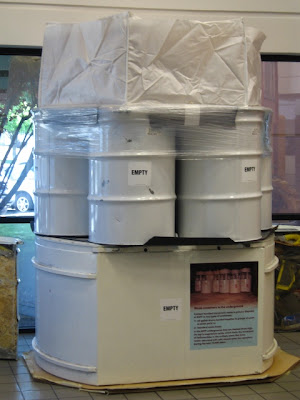Tonight I write from the lobby of an air-conditioned, smoke-filled, slot-filled Vegas casino, but yesterday we had direct and extended contact with the Mojave Desert. The silence was palpable. I learned today that Mojave covers over 22,ooo square miles. That means, that from where I am writing, I am still residing upon it. Yesterday I felt I was becoming the desert, tonight I am buffered from it.
The Mojave runs from the edge of Los Angeles at the San Gabriel Mountains all the way across California to Las Vegas, including the Nevada Test Site and Death Valley. This linkage through desert extension was an enormous discovery for us -and our current sense of place. Essentially these cities, especially Las Vegas, reside upon the desert. This is serious high desert, one of the most extreme landscapes that I have spent time in. This morning on a walk I could feel my lips drying in the sun. I could feel the water that I drank move down my throat. Out there (here?) it is all dry heat, no warmth. You feel yourself becoming salt, becoming smaller, drier, more of the land within seconds of exposure. It seems obvious that millions of people inhabiting the desert are living on a precarious edge. If systems fail the desert, and its geological forces, will immediately start to take the land back. The earth has history on its side.
Yesterday we saw the remnants of ancient
Lake Mojave, another Pleistocene lake. Today, all that is left is the deep humming
Kelso Dunes. We also saw the
Cima batholith.

Oasis Cafe, Nipton, CA

the gateway to the Mojave Preserve, actually a pretty odd place to spend the night

inside the Preserve


the beautiful red orange roads of the Preserve, goodbye Nipton
The words of Matt Coolidge rang in my ears in the Mojave. Though they were written for the context of Clean Livin' (where we resided at the start of our journey) they rang true for the moment, and the trip at large that we currently find ourselves deeply embedded within.
"Because it is located off the grid on the edge of a landscape void, the project is also about autonomy, isolation, making do with a bare minimum, making something from next to nothing and exploring the basement of one's will...I see the project as about starting over from the ruins of the military, about the birth of the atomic age, and the possibility of global Armageddon. It's about making lemonade from lemons." -Matt Coolidge on Clean Livin'and what is a day in the Mojave without Baudrillard's America:"Driving is a spectacular form of amnesia. Everything to be discovered, everything to be obliterated. Admittedly, there is the primal shock of the deserts and the dazzle of California, but when this is gone, the secondary brilliance of the journey begins, that of the excessive, pitiless distance, the infinity of anonymous faces and distances, or of certain miraculous geological formations, which ultimately testify to no human will, while keeping intact an image of upheaval.""The desert is a natural extension of the inner silence of the body. If humanity's language, technology, and buildings are an extension of its constructive faculties, the desert alone is an extension of its capacity for absence, the ideal schema of humanity's disappearance. When you come out of the Mojave, writes Banham, it is difficult to focus less than fifteen miles ahead of you. You eye can no longer rest on objects that are near. It can no longer properly settle on things, and all the human or natural constructions that intercept your gaze seem irksome obstacles which merely corrupt the perfect reach of your vision. When you emerge from the desert, you eyes go on trying to create emptiness all around; in every inhabited area, every landscape they see desert beneath, like a watermark.""And yet, in another sense, there is nothing to match night falling in its shroud of silence on Death Valley, seen from broken-down, worn-out motel chairs on the veranda, looking out over the dunes. The heat does not fall off here. Only night falls, its darkness pierced by a few car headlights. And the silence is something extraordinary, as though it were itself all ears. It is not the silence of cold, nor of barrenness, nor of an absence of life. It is the silence of the whole of this heat over the mineral expanses that stretch out before us for hundreds of miles, the silence of the gentle wind upon the salt mud of Badwater, caressing the ore deposits of Telegraph Peak. A silence internal to the Valley itself, the silence of underwater erosion, below the very waterline of time, as it is below the level of the sea. No animal movement. Nothing dreams here, nothing talks in its sleep. Each night the earth plunges into perfectly calm darkness, into the blackness of it alkaline gestation, into the happy depression of its birth."


















































